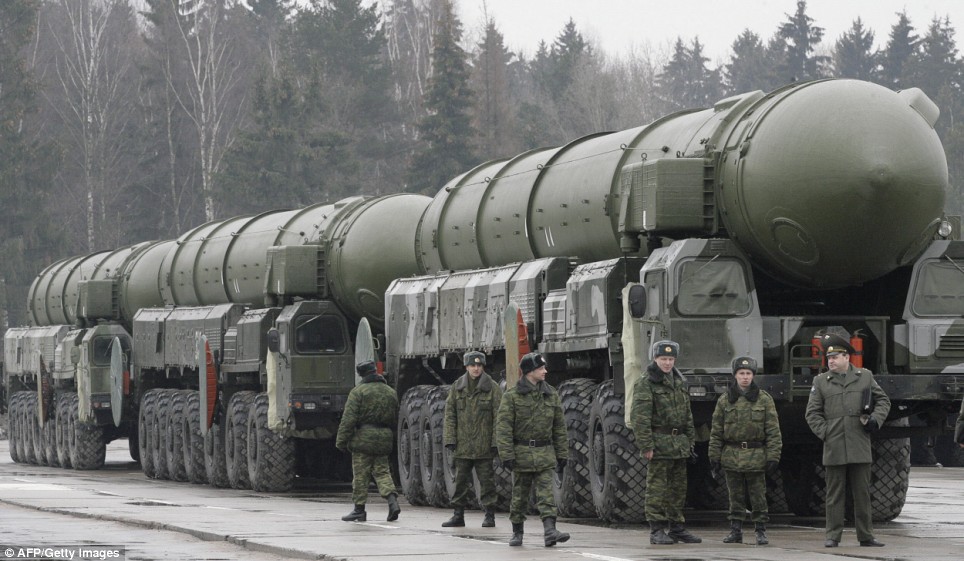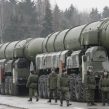
Russia Will Retain as Many Nuclear Weapons as Possible
Publication: Eurasia Daily Monitor Volume: 6 Issue: 68
By:

On April 5 President Barack Obama in his speech in Prague, outlined his vision of a nuclear-free world: "This goal will not be reached quickly -perhaps not in my lifetime. It will take patience and persistence. But now we, too, must ignore the voices who tell us that the world cannot change." Obama argued that if nuclear nations eliminated their arsenals, others would not move to acquire such weapons. He implied that the process of nuclear reduction began in London after a summit with President Dmitry Medvedev when it was agreed to prepare "by the end of this year a legally binding and sufficiently bold" new arms reduction treaty. This treaty, according to Obama "will set the stage for further cuts, and we will seek to include all nuclear weapons states in this endeavor." He added, "As long as these weapons exist, we will maintain a safe, secure and effective arsenal to deter any adversary, and guarantee that defense to our allies" (AP, April 5).
In the Cold War Russian Communist leaders often used the theme of the elimination of nuclear weapons as a propaganda weapon to prod Western adversaries. Nuclear disarmament per se was never truly considered by the Russian military, but even if the West publicly took up the nuclear disarmament offer at face value, it was considered a safe option: during the Cold War Russia had a clear conventional troop superiority in Europe and an elimination of the nuclear deterrent would have shifted the balance in its favor.
Now the situation is radically different: Russia’s conventional forces are weak and outdated, while Western militaries are in the midst of a military-technical revolution, acquiring new capabilities of precision warfare that the Russians can only dream about. Russia’s nuclear deterrent is seen as practically the only item left that still keeps the country in the league of military superpowers. Safeguarding a credible nuclear deterrent is the main strategic goal of Russian military chiefs, diplomats and political leaders. Obama’s nuclear-free world vision was publicly ignored by the officialdom in Moscow (www.newsru.com, April 7).
The notion of significant nuclear disarmament is unacceptable to the Russian military and coming from an American president it is regarded as a cynical ploy to gain total military superiority over the country. Obama pledged in Prague, "To achieve a global ban on nuclear testing, my administration will immediately and aggressively pursue U.S. ratification of the Comprehensive Test Ban Treaty [CTBT]" (Reuters, April 5). Russia ratified the 1996 CTBT, while the U.S. remains only a signatory. Obama’s intention to finally ratify the CTBT is not good news to some in Moscow. Russia has been conducting for many years "subcritical nuclear tests" at the Novaya Zemlya testing site, which models a nuclear explosion. The Russian military has argued that the U.S. is conducting similar tests in Nevada (Nezavisimoye Voyennoye Obozreniye, September 19, 2007). Similarly, the Russian military and nuclear-industrial lobbies have anticipated a possible resumption of genuine nuclear testing at Novaya Zemlya citing the U.S. failure to ratify CTBT as a pretext.
Russia is indeed ready to negotiate a new arms reduction treaty with the U.S. to replace the 1991 Strategic Arms Reduction Treaty (START), which expires in December. Under the subsequent 2002 Strategic Offensive Reductions Treaty (SORT), Russia and the U.S. agreed to limit their strategic nuclear warheads to between 1,700 and 2,200 by 2012. The SORT did not establish its own verification system, using instead the existing provisions in the expiring START. A possible new comprehensive treaty would establish new verification provisions and limit strategic warhead arsenals to 1,500 on either side. Obama is scheduled to visit Moscow in July, where he may sign a framework agreement on strategic nuclear arms and then in December, a full treaty could be signed (RIA-Novosti, April 1).
Russia is struggling to maintain and replace its ageing strategic nuclear delivery systems -missiles, bombers and nuclear submarines. In any case, by 2020 its deployed strategic nuclear arsenal will be 1,500 or less. Signing a binding treaty that limits the U.S. to the same number of warheads is clearly advantageous. However, the coming arms control negotiations will not be easy, as both the recently appointed U.S. Assistant Secretary of State for verification and compliance, Rose Gottemoeller and Russia’s ambassador to the United States, Sergei Kislyak have acknowledged (RIA-Novosti, April 8). Moscow will be seeking strict guarantees that the U.S. will not retain a capability to rapidly re-expand its strategic nuclear arsenal.
In Prague Obama announced, "As long as the threat from Iran persists, we intend to go forward with a missile defense system that is cost-effective and proven." This apparent linkage of plans to deploy Ballistic Missile Defense (BMD) components in the Czech Republic and Poland with Iranian missile and nuclear development was extensively reported in Moscow (RIA-Novosti, Interfax, April 5). The Russian Foreign Minister Sergei Lavrov said President Medvedev’s view is that the planned deployment of the BMD in Eastern Europe has nothing to do with an alleged Iranian threat and that any linkage of the two issues is unacceptable. In turn, Lavrov stated that development of BMD and strategic nuclear arms control are linked only in that the U.S. BMD system will threaten Russia (Rossyskaya Gazeta, April 6).
Russia is likely to link any possible cuts of its strategic nuclear weapons under 1,500 warheads to the U.S. agreeing to strictly limit or abandon its BMD plans. Obama’s aim to drastically cut nuclear weapons while linking missile defense development to Iranian behavior is seen in Moscow as a conspiracy aimed at negating in future Russia’s precious nuclear deterrent. A nuclear-free world, from Moscow’s perspective, appears to be a distant dream.




